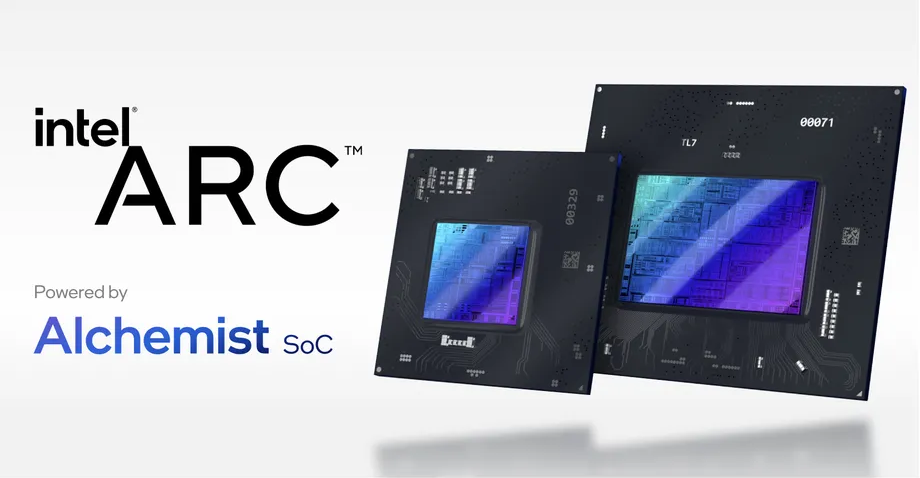Intel is set to release its first Alchemist GPUs under the Arc brand next year. The curtains have been panned back slowly by Intel to reveal more and more information each week. But, whereas most of the conversation has been derived from what Intel itself has disclosed, an early benchmark leak has surfaced today, shifting the narrative to one that makes us question the braggadocios pre-marketing from Intel.

The Story So Far
For those out of the loop, Intel is finally stepping foot in the discrete graphics space with its Arc Alchemist graphics cards early next year. Intel will go head-to-head with AMD and Nvidia to fight for the consumer’s pocket. So far, we know that two different models will be available at launch, a 128EU card and a 512EU card, with the latter likely competing with the RTX 3070. Alchemist GPUs will be based on the Xe-HPG microarchitecture and will support all the latest features such as ray tracing, AI super-sampling, and DX12 Ultimate.

Intel also has plans to introduce their Xe-HPG (High Performance Gaming) chips in the mobile form factor. And, it appears as if we’ve gotten our first look at exactly that. First spotted by Benchleaks, the popular benchmarking site, Geekbench is showing a new listing for a Xe-HPG GPU in their database. While leaks like these are always to be taken with a grain of salt, what we see does not look as promising as we were, uhm, promised.
The Geekbench Leak
The Alchemist GPU spotted in the leak is one that packs 512EUs (Execution Units), but the official Intel name for these is Xe-Cores. Regardless, this means that we’re looking at possibly the highest-end mobile GPU from Arc Alchemist. In the benchmark, it appears to have been paired with a Tiger Lake processor, the Core i7-11800H to be specific, and the device has 32 GB of DDR4 memory.

We can see that the GPU sports a maximum boost clock of 1.8Ghz but as this is certainly a pre-production silicone, the final chip could have a higher (or lower) maximum frequency. The fact that is was paired with a Tiger Lake CPU, though, tells us that Alchemist will debut on the next batch of current-gen laptops first before Alder Lake and before making its way over to the discrete market.
Interestingly enough, we’ve already had a leak previously where a 512EU Xe-HPG GPU was seen in tandem with an Alder Lake chip, but the score was drastically lower. They were so bad that it couldn’t even compete with GeForce 500-series cards. Hence, it was easy to tell that no drivers had yet been optimized for the GPU. But, several months later and with a slower Tiger Lake chip this time, the scores are much better which means that Intel is well on track.
Speaking of which, the GPU was able to net 34,816 points as its OpenCL score in today’s leak. To be fair, that’s not a great score either but it’s significantly better (4.5x) than the 7,943 OpenCL score we saw for Xe-HPG the last time. As compared to the already established players, yeah, it’s not looking good. The GPU is struggling to hold a candle to even the GTX 1650 Max-Q but it’s faster than lower-end SKUs, at least.

How It Stacks Up
There have been leaks surrounding the 128EU and 256EU models as well. Both of them have leaked on Geekbench before and the 512EU GPU is expectedly more performant that those. The 128EU model scored 16,243 OpenCL points while the 256EU model achieved 18,482 OpenCL points. In contrast, the 512EU model is about 85% faster than its one-step-down 256EU variant. However, there is going to be a 384EU model as well, but we don’t know much about it right now.
The discrete version of the 512EU Alchemist GPU is supposed to rival the RTX 3070 however. So, to see such a significant dip in performance on its mobile variant is somewhat worrying. Somewhat because it’s a leak first of all, but also because this is a sample unit with much room for further optimization. I mean the improvement from March’s leak to today’s is 4.5x so I expect it to only get better.
Arc Alchemist also marks the first time that Intel outsources its chips. TSMC‘s 6nm (N6) node will be used to manufacture Alchemist on both desktop and mobile. This puts Intel at an inventory advantage over AMD, who uses 7nm for now, as it won’t have to compete for the 6nm stock allocation. Both discrete and mobile versions of Alchemist GPUs are set to launch in the first quarter of 2022.
The post Leaked Benchmark Shows Intel Arc Alchemist 512EU Mobile GPU in Action, Slower Than GTX 1650 Max-Q appeared first on Appuals.com.


0 Commentaires